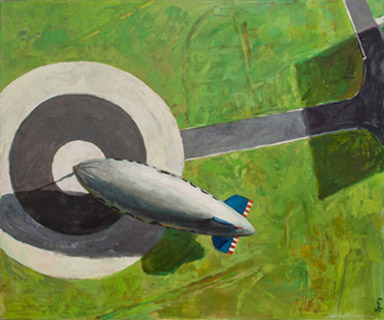
Opening January 7, 2012
From 1959 to 1962 Roger Kuntz produced a series of Southern California landscape paintings that pulled back the image of the illusory blue sky and orange orchards, mountain ranges and seascape images from our gaze to reveal a broad abstract and stubbornly grounded real space that was about to create a new legacy. What he saw and painted was a landscape of freeway signs, ramps, concrete canyons, and tunnels. It was essentially the image of an urban landscape of a changing world, of utilitarian roads that converged and flowed from one area to another. In this PST moment, the exhibition of these works and of Kuntz’s contributions to California art is most timely.
Born in San Antonio, Texas in 1926, Kuntz was brought up in Lomaland, the Theosophist Alternative Commune in Point Loma (in San Diego), and a likely point of reference to his life-long commitment to Zen Buddhism. Earning his BA degree at Pomona College, where he later taught, he spent the rest of his too brief life in Laguna Beach. By 1950 he became convinced that the pastoral narrative of sunny California was ending along with the non-representational dominance of Abstract Expressionism.
Turning toward a new representational painting, he began a series of works on the system of signs that identify Southern California: those images, directions, letters and symbols that dominate this space. The result was the “Freeway Series.” National recognition followed. In October 1962, Life magazine published a special issue on California, “The Call to California: Its splendor, it’s excitement. Why people go, go, go there.” Along with features on the entertainment industry and the scenic wonders of the state, novelist Irving Stone contributed a “biography” of California. The art scene was represented by photographs of artists Stanton MacDonald-Wright, John McLaughlin, Billy Al Bengston, Robert Irwin - and Kuntz. Photographed on the beach, wearing a wet-suit, easel in hand, blond and buff, he personified the iconic surfer/artist. The year prior Felix Landau had exhibited the “Freeway” works, and the next year Walter Hopps organized a solo exhibition at the Pasadena Art Museum. In 1975, after a three-year battle with cancer, Kuntz ended his life. His name and work gradually slipped into oblivion.
Yet, as this exhibition of some 14 paintings reveals, Kuntz’ creation of a new painterly space explored the shadow and light of canyons, tunnels and ramps, a space curator Susan Anderson entitled “The Shadow Between Representation and Abstraction” in 2009 on the occasion of the first and only retrospective of his work, at the Laguna Art Museum.
In “Pasadena Route 66” black and marine blue cover the surface. A diagonal line cuts across the lower right hand of the canvas while two squares sit off-center in the middle of the work. The word, “Pasadena” is painted against them, but what dominates the painting is the word ‘East’ emblazoned in white, along with the iconic sign/symbol ‘66.’ A white arrow points downward on the left hand side. Graphic and yet representational, each sign is understood. Kuntz is depicting familiar images even as he defines them in abstract terms.
More enigmatic are “Do Not Enter” (Freeway Series) and “Stop” (Sign Series), which share the same palette and the composition as the work above. Half painted over and incomplete (in “Stop” the words read vertically down the canvas), these commands emulate the sense of driving on L.A.’s streets and roads, seeing commands that guide our travels along these concrete highways but of which we are barely aware.
In “Double Arrow 90” (Sign Series) and “Bent Arrow,” (Freeway Series) the sign/symbols are reduced to graphic abstraction and simultaneously, a choice between two pathways. Again, the enigmatic concept of road, journey and choice light up these works. Signs become more than simple directions. They offer us pathways.
Two “Blimp” paintings, “Blimp on Target” and “Blimp Overhead” go back to Kuntz’s fascination with the floating projectile that so often drifts across a clear, lazy sky. Again, shape and form dominate the works. The interplay of shadow and light in the first, and the immensity of the blue-sky background in the second speak to freedom and grounding. Early in his career, Kuntz also painted blimps on the surface of the moon. These enormous air-borne ships evoke a sense of infinite longing, soaring as they do beyond the asphalt and concrete world of our streets and freeways.
Published courtesy of ArtSceneCal ©2012
